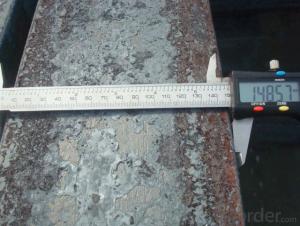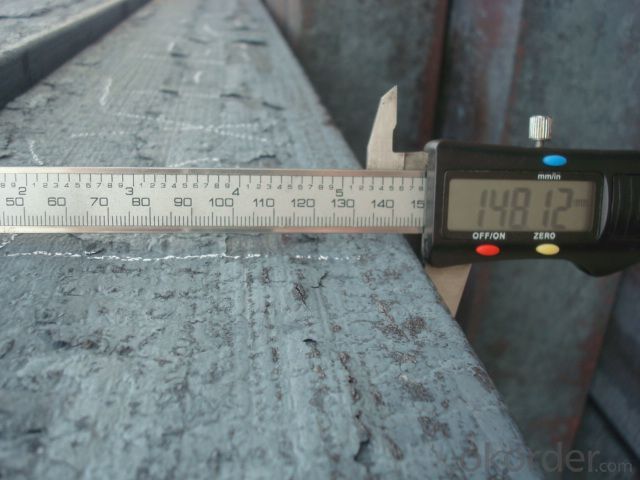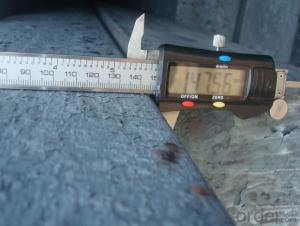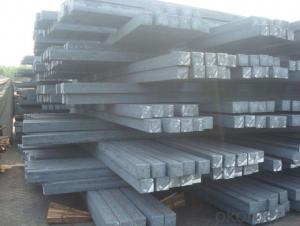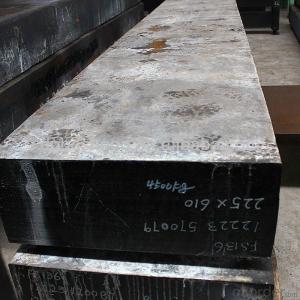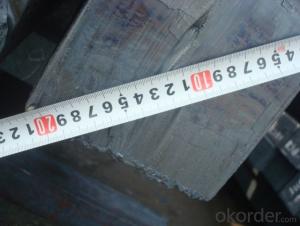Steel Billet Manufactured by Blast Furnace without Boron
- Loading Port:
- Tianjin
- Payment Terms:
- TT OR LC
- Min Order Qty:
- 1000 m.t.
- Supply Capability:
- 100000 m.t./month
OKorder Service Pledge
OKorder Financial Service
You Might Also Like
Steel Billet Manufactured by Blast Furnace without Boron
1.Structure of Steel Billet Manufactured by Blast Furnace without Boron
Steel Billet Manufactured by Blast Furnace without Boron is the raw material of all kinds of steel mill. Billet section of square, round, flat, rectangular and abnormity, etc Several, mainly related to shape of rolled products. Simple rolled section steel, choose cross section of square billet or rectangular billet. rolling The sector products such as flat steel, Angle steel, select the rectangular billet or slab. Had better profiled billet when production beams, channels, and in rolling process Lines and improve the yield. The raw material of round billet is the production of seamless tube.
2.Main Features of Steel Billet Manufactured by Blast Furnace without Boron.
Steel Billet Manufactured by Blast Furnace without Boron section size should meet the requirements of rolling deformation and finished product quality, but also roll strength and biting condition of restrictions. General steel Billet section height H. And the roll diameter D The ratio of the ( namely H/D) Should be less than or equal to zero 0.5 . Length of steel billet by finishing temperature, Rolling time and the length of the product Or times ruler. When heated too long accident prone to bump the furnace wall of steel, too short, furnace bottom utilization rate is not high, influence the heating furnace production. For the production Choose a variety of steel and steel billet, should consider the affinities of billet, as far as possible in order to improve the productivity of the roughing mill, simplify the stock management of workshop.
3. Steel Billet Manufactured by Blast Furnace without Boron Images
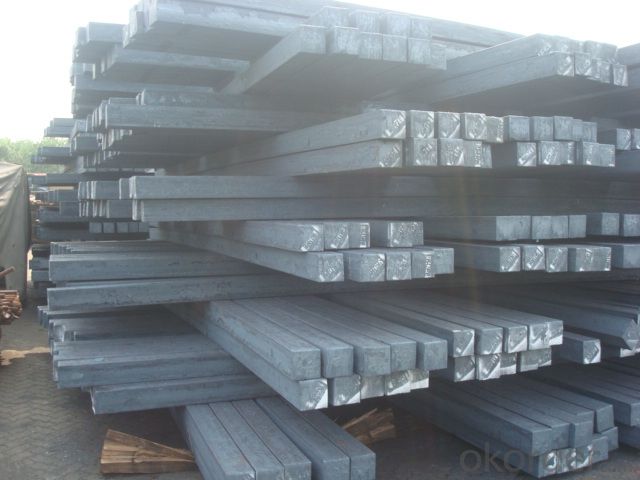
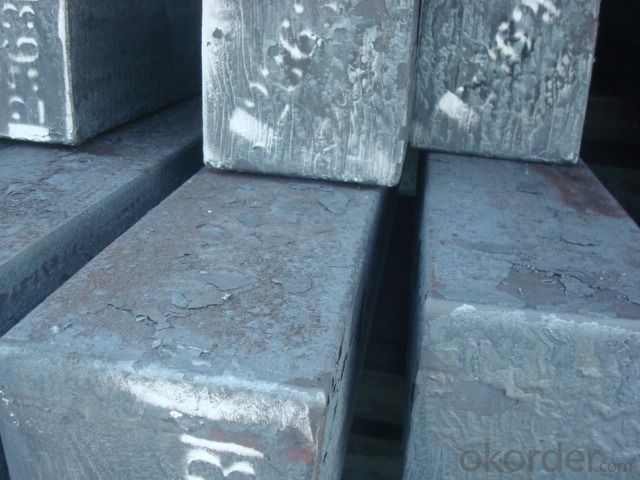
4. Steel Billet Manufactured by Blast Furnace without Boron Specification
Steel Billet Manufactured by Blast Furnace without Boron rolled steel, after processing can be used for mechanical parts, forging parts, processing all kinds of steel, steel Q345B channel steel, wire rod is the role of the billet. Steel billet is used in the production of semi-finished products, generally cannot be used directly for the society. Steel billets and steel are strictly divided into standard, cannot decide to whether the business enterprise of the final product, and according to unified standards to perform the whole society. Typically, billet and the steel is relatively easy to distinguish, but for some steel billet, and have the same specification and same steel purposes (such as rolling tube billet), whether can be used for other industries, whether through steel processing process, whether through a finished product rolling mill processing to distinguish
The classification of the Bloom Mainly from the shape is divided into two kinds: Slab: cross section width and height of the ratio of the larger, mainly used for rolling plate. Bloom: equal cross section width and height, or a huge difference, mainly used for rolling steel, wire rod.
Bloom material standard The thickness range: 150-240 - mm + / - 5 mm The width of the range: 880-1530 - mm + / - 20 mm Length range: 3700-10000 - mm + / - 500 - mm Cross-sectional size: 64 * 64 ; 82 * 82 ; 98 * 98 ; 124 * 124 ; 120 * 150 ; 152 * 164 ; 152 * 170 mm Length: 9000 mm The section of tolerance: Bloom: 1.0 + / - 2.0-1.0 + / - 1.0 mm The slab width: + / - 2.0 MM ; Thickness: + / - 3.0 MM
5.FAQ of Steel Billet Manufactured by Blast Furnace without Boron
We have organized several common questions for our clients,may help you sincerely:
①How about your company?
A world class manufacturer & supplier of castings forging in carbon steel and alloy steel,is one of the large-scale professional investment casting production bases in China,consisting of both casting foundry forging and machining factory. Annually more than 8000 tons Precision casting and forging parts are exported to markets in Europe,America and Japan. OEM casting and forging service available according to customer’s requirements.
②How to guarantee the quality of the products?
We have established the international advanced quality management system,every link from raw material to final product we have strict quality test;We resolutely put an end to unqualified products flowing into the market. At the same time, we will provide necessary follow-up service assurance.
③How is the packaging and delivery?
Exporting Package with the steel material cover and the delivery term is based on the project.
- Q: What are the major steel billet producing countries?
- The major steel billet producing countries include China, India, Russia, Japan, and the United States.
- Q: What are the different surface treatment options for steel billets?
- There are several different surface treatment options available for steel billets, depending on the specific requirements and applications. Some of the common surface treatment methods for steel billets include: 1. Pickling: This process involves immersing the steel billets in an acid solution to remove any scales or impurities on the surface. Pickling helps to improve the surface finish and prepare the steel for further treatment or processing. 2. Shot blasting: Shot blasting is a mechanical process that involves propelling small steel shots at high velocity onto the surface of the billets. This treatment helps to remove rust, scales, and other contaminants, resulting in a clean and smooth surface finish. 3. Phosphating: Phosphating is a chemical treatment method that involves applying a phosphate coating onto the steel billets' surface. This process helps to improve corrosion resistance, enhance paint adhesion, and provide a uniform surface for subsequent treatments. 4. Galvanizing: Galvanizing is a popular surface treatment option where a layer of zinc is applied to the steel billets' surface through a hot-dip or electroplating process. This treatment provides excellent corrosion resistance, making it suitable for outdoor applications. 5. Coating: Steel billets can be coated with various materials, such as epoxy, polyurethane, or powder coatings, to enhance their appearance, provide additional corrosion protection, or improve resistance to wear and tear. 6. Passivation: Passivation is a chemical treatment process that aims to remove any free iron or iron oxide from the steel billets' surface and form a protective oxide layer. This treatment helps to increase corrosion resistance and improve the billets' overall performance. It is important to consider the specific requirements and intended use of the steel billets when selecting the appropriate surface treatment method. Factors such as corrosion resistance, appearance, adhesion, and wear resistance should be taken into account to ensure the desired performance and longevity of the steel billets.
- Q: What types of steel are commonly used for billets?
- Billets, commonly used in various industries, require different types of steel depending on specific needs and desired properties. For instance, carbon steel is a popular choice due to its affordability, durability, and high strength. It is an alloy of iron and carbon, suitable for applications in construction, automotive, and machinery industries. Alloy steel, on the other hand, involves the addition of alloying elements like chromium, nickel, and molybdenum to carbon steel. This enhances the steel's strength, toughness, and corrosion resistance, making it ideal for demanding applications such as aerospace, oil and gas, and power generation. Stainless steel, known for its corrosion resistance, finds extensive use in billets for applications where protection against corrosion is critical, like marine environments and food processing industries. It is created by adding chromium and other elements like nickel or molybdenum to carbon steel, resulting in excellent resistance to corrosion, high temperatures, and chemicals. Lastly, tool steel is specifically designed for the manufacturing of tools and dies. It contains alloying elements like tungsten, vanadium, or cobalt, providing exceptional hardness, wear resistance, and heat resistance properties. These billets are crucial for producing precision tools and components used in industries like automotive, aerospace, and manufacturing. In conclusion, carbon steel, alloy steel, stainless steel, and tool steel are commonly utilized for billets. The selection of steel depends on the specific requirements of the application, such as strength, corrosion resistance, or hardness.
- Q: What is the role of steel billets in the construction of offshore platforms?
- Steel billets play a crucial role in the construction of offshore platforms. These platforms are massive structures that are installed in the open sea to extract oil or gas from beneath the ocean floor. Due to the harsh environmental conditions and the need for utmost safety and durability, steel billets are widely used in their construction. One of the primary functions of steel billets is to provide the raw material for the fabrication of various components of offshore platforms. Billets are large, semi-finished steel products that are typically used as starting material for the production of other steel products. They are cast into a specific shape, usually a square or a rectangle, and have a solid cross-section. Offshore platforms require steel with exceptional strength, corrosion resistance, and impact toughness to withstand the challenging conditions they face, such as strong waves, harsh weather, and extreme temperatures. Steel billets are often made from high-strength alloyed steels, which offer superior mechanical properties and resistance to corrosion. These billets are then further processed to manufacture different structural elements of offshore platforms, including beams, columns, braces, and other support structures. These components must be able to support the weight of the platform itself, as well as withstand the forces generated by ocean waves, wind, and the extraction process. Moreover, steel billets are also used in the production of pipes and tubes, which are vital for transporting oil and gas from beneath the seabed to the platform or to the shore. These pipes need to be strong, durable, and resistant to corrosion to ensure the safe and efficient flow of hydrocarbons. In summary, steel billets serve as the building blocks for the construction of offshore platforms. They provide the raw material for fabricating various structural components, ensuring the strength, durability, and safety of these massive structures in the challenging offshore environment.
- Q: What are the different methods of steel billet surface cleaning?
- There are several methods of steel billet surface cleaning, each with its own advantages and disadvantages. Some of the common methods include: 1. Shot Blasting: This method involves shooting small metallic or non-metallic particles at high velocity onto the surface of the billet. The impact of these particles removes any rust, scale, or surface contaminants. Shot blasting is an effective method for cleaning large surfaces quickly, but it can cause surface roughness and may not be suitable for all types of steel. 2. Acid Pickling: Acid pickling involves immersing the steel billet in an acid solution, typically hydrochloric or sulfuric acid, to remove scale and rust. The acid reacts with the surface contaminants, dissolving them and leaving a clean surface. Acid pickling is effective in removing stubborn scale and rust, but it requires careful handling of the corrosive acids and proper disposal of the waste. 3. Mechanical Cleaning: Mechanical cleaning methods involve using abrasive tools or brushes to physically scrub the surface of the billet. This can be done manually or using machinery. Mechanical cleaning is effective in removing loose contaminants and scale, but it may not be suitable for heavily rusted or stubbornly adhered contaminants. 4. High-Pressure Water Jetting: This method uses high-pressure water jets to clean the surface of the billet. The force of the water removes scale, rust, and other contaminants. High-pressure water jetting is environmentally friendly as it does not involve the use of chemicals, but it may not be as effective in removing heavy scale or rust. 5. Ultrasonic Cleaning: Ultrasonic cleaning involves immersing the steel billet in a tank filled with a cleaning solution and subjecting it to high-frequency ultrasonic vibrations. The vibrations create tiny bubbles in the cleaning solution, which implode on the surface of the billet, effectively removing contaminants. Ultrasonic cleaning is effective in removing even microscopic particles and can reach complex geometries, but it may not be suitable for large-scale cleaning operations. Each of these methods has its own strengths and limitations, and the choice of method depends on factors such as the type and condition of the surface contaminants, the time and cost constraints, and the desired surface finish.
- Q: How are steel billets used in the production of transmission components?
- In the production of transmission components, steel billets are indispensable raw materials. These semi-finished products are typically obtained through the casting process and have a rectangular or square shape with a larger cross-sectional area compared to the final product. To shape the steel billets into the desired forms, a series of processes such as forging, rolling, or extrusion are employed. Each of these processes aims to transform the steel billets into specific shapes and sizes required for transmission components like gears, shafts, bearings, and housings. Forging is a widely used method for shaping steel billets. It involves heating the billet and using mechanical force to deform it into the desired shape, thereby enhancing the strength and durability of the transmission components. Rolling, on the other hand, gradually reduces the cross-sectional area of the steel billets by passing them through a series of rollers. This process helps achieve the desired shape and dimensions of the components. In certain cases, extrusion is employed to produce complex shapes. This process involves forcing the steel billets through a die to obtain the desired form, allowing for the production of intricate transmission components like splined shafts or valves. After shaping the steel billets into the required forms, further machining processes such as cutting, drilling, and grinding are carried out to achieve the final specifications. These components are then heat-treated and coated to enhance their strength, durability, and resistance to corrosion. In summary, steel billets play a crucial role in the production of transmission components as they provide a versatile and reliable raw material that can be shaped into various forms. They ensure that the transmission components possess the necessary strength, durability, and precision required for efficient and reliable operation in vehicles and machinery.
- Q: How do steel billets contribute to the overall sustainability of a product?
- Steel billets play a crucial role in enhancing the overall sustainability of a product. Firstly, steel is one of the most widely recycled materials in the world, and using steel billets in the manufacturing process allows for a closed-loop recycling system. This means that the steel billets can be continuously recycled and reused without any loss in quality or performance. Recycling steel reduces the need for extracting raw materials, conserving natural resources, and reducing energy consumption, ultimately reducing the carbon footprint of the product. Additionally, steel billets contribute to the durability and longevity of a product. Steel is a highly durable material that can withstand harsh environmental conditions and heavy usage. By using steel billets in the production process, products are made to last longer, reducing the need for frequent replacement and minimizing waste generation. Furthermore, steel billets can be used in various industries, including construction, automotive, and manufacturing, where sustainability is of utmost importance. Steel structures and components made from steel billets are known for their high strength-to-weight ratio, allowing for lighter structures and vehicles. This leads to reduced energy consumption during transportation and improved fuel efficiency in the case of automobiles, ultimately reducing greenhouse gas emissions. Moreover, steel is a non-toxic material and does not release harmful substances into the environment. This ensures that products made from steel billets are safe for both consumers and the environment throughout their lifecycle. In conclusion, steel billets contribute significantly to the overall sustainability of a product by enabling closed-loop recycling, reducing the need for raw materials extraction, increasing product durability, promoting energy efficiency, and being non-toxic. By incorporating steel billets into the production process, manufacturers can enhance the environmental performance of their products and contribute to a more sustainable future.
- Q: How do steel billets contribute to the overall seismic resistance of a structure?
- Steel billets contribute to the overall seismic resistance of a structure by providing strength, ductility, and energy dissipation capabilities. Due to their high strength-to-weight ratio, steel billets help in resisting the lateral forces generated during an earthquake. Their ductility allows them to undergo significant deformation without failure, absorbing and dissipating the seismic energy. Additionally, their uniformity and consistency in material properties make them reliable components for structural systems, enhancing the overall stability and resilience of the structure against seismic events.
- Q: What are the different surface treatments for improved machinability in steel billets?
- To enhance the machinability of steel billets, there are multiple surface treatments available. These treatments aim to optimize cutting performance and minimize tool wear during machining operations. Here are some common methods used to improve machinability in steel billets: 1. Nitriding: Nitriding is a surface hardening treatment that utilizes nitrogen to form a durable and wear-resistant layer on the steel billet's surface. By undergoing this treatment, the cutting performance is enhanced, and tool wear during machining is reduced. 2. Carburizing: Carburizing is a process that involves infusing carbon into the surface of the steel billet to increase its hardness and wear resistance. This treatment improves machinability by creating a harder surface layer capable of withstanding higher cutting speeds and loads. 3. Coating: The application of various coatings on the surface of steel billets can decrease friction and enhance machinability. Examples of such coatings include titanium nitride (TiN) and diamond-like carbon (DLC) coatings. These coatings minimize tool wear and improve cutting performance. 4. Shot peening: Shot peening is a surface treatment that entails bombarding the steel billet's surface with small spherical particles. This treatment induces compressive stress, enhancing fatigue resistance and decreasing the likelihood of crack initiation during machining. 5. Cold working: Cold working involves deforming the steel billet at room temperature to increase its hardness and improve machinability. Cold rolling or cold drawing are processes commonly employed to achieve this treatment. It is crucial to bear in mind that the selection of a surface treatment for improved machinability in steel billets depends on various factors, including the specific steel alloy, desired surface properties, and intended machining process. Consequently, it is essential to consider these factors and seek expert advice to determine the most suitable surface treatment for a particular application.
- Q: What are the different shapes of steel billets?
- Steel billets can come in various shapes, including square, round, rectangular, and hexagonal.
Send your message to us
Steel Billet Manufactured by Blast Furnace without Boron
- Loading Port:
- Tianjin
- Payment Terms:
- TT OR LC
- Min Order Qty:
- 1000 m.t.
- Supply Capability:
- 100000 m.t./month
OKorder Service Pledge
OKorder Financial Service
Similar products
Hot products
Hot Searches
Related keywords
